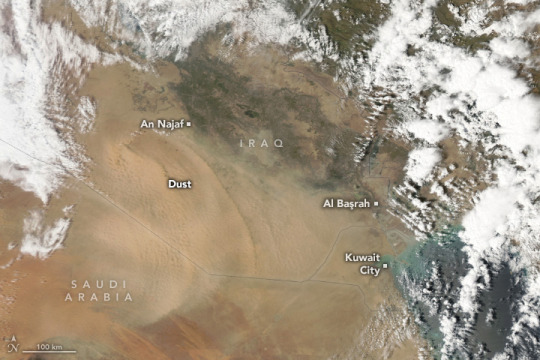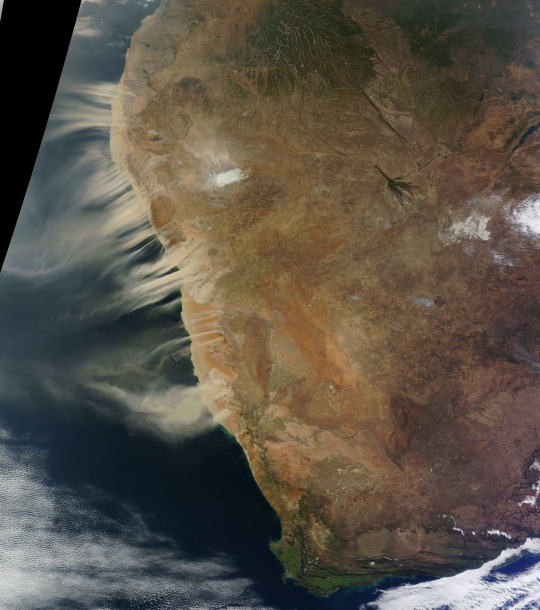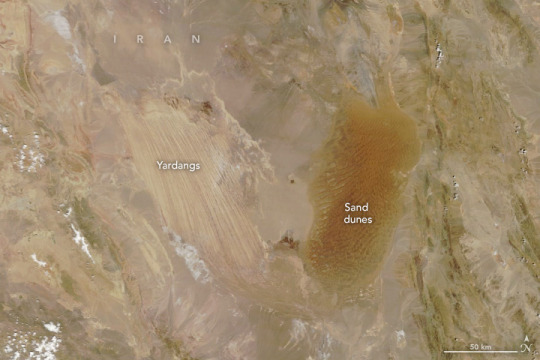#modis
Explore tagged Tumblr posts
Photo

Image: NASA Worldview This may well be a low pressure system swirling in the Southern Ocean west of Australia, as imaged by the MODIS instrument on NASA's Terra Satellite on March 3.
#NASA#world#earth#hurricane#southern ocean#australia#terra satellite#satellite#MODIS#space#landscape#nature#eye#art#photography#u
3K notes
·
View notes
Text

On October 7, 2023, the Moderate Resolution Imaging Spectroradiometer (MODIS) on NASA’s Terra satellite acquired a true-color image of “The Eye of the Sahara”.
Although it looks like it could be an impact crater, it actually formed when a volcanic dome hardened and then gradually eroded, slowly exposing the ringed rock layers. The result is an onion-like formation, with ridges formed of weather-resistant rocks while less-resistant rock forms valleys between the ridges. Some of the igneous rocks found within the structure have been dated as having cooled between 94 and 104 million years ago.
Richat Structure in Mauritania
14 notes
·
View notes
Photo

Mosaic of Antarctica
Antarctica is the coldest, driest and windiest place on Earth – and, during the austral summer, it is also the sunniest. Due to the tilt of the Earth’s axis in relation of the sun, the frozen land south of the Antarctic Circle receives six months of daylight in summertime, and six months of darkness in winter. The long hours of sunshine allow for excellent imagery of the region from space.
This true-color mosaic of Antarctica was created from images acquired by multiple passes of the Moderate Resolution Imaging Spectroradiometer (MODIS) aboard the Terra satellite on December 16, 2013. Because Terra is in a polar orbit, it passes over each pole approximately 14 times a day, and acquires an image on each pass. To create a mosaic, the data that are closest to the center of each swath – where edge distortion is minimized – are used to create a complete view of the region.
The MODIS Rapid Response system generates complete mosaic images of Antarctica every day in austral late spring, summer and early fall. Because the light is poor in austral late fall, winter and early spring, MODIS images are not created during that period. A mosaic of Antarctica can be found for any given day at NASA’s Project Antarctica at rapidfire.sci.gsfc.nasa.gov/subsets/?project=antarctica
Credit: NASA/GSFC/Jeff Schmaltz/MODIS Land Rapid Response Team
2 notes
·
View notes
Text
Profil Cucu Milo atau Biodata Layla Hapita Sedang Viral dan Terpopuler
#Terviral – #Profil #CucuMilo atau #Biodata Layla Hapita Sedang #Viral dan #Terpopuler. Belakangan ini, media sosial (#medsos), khususnya #TikTok kembali diramaikan dengan sosok #wanita ber #hijab yang dikenal dengan nama Cucu Milo. Sosoknya viral dan berseliweran di FYP (For Your Page) TikTok, dan membuat banyak orang yang baru pertama kali melihatnya merasa penasaran siapa sebenarnya sosok di…
#Abg Viral#Berhijab#Biodata#Biodata Cucu Milo#Biodata Viral#Biografi#Cantik Viral#Cewek Viral#Cucu Milo#CucuMilo#FYP#Gadis#Gadis Viral#Gemoy#Hijab#Hijab Viral#Layla Hapita#Medsos#Modis#Paling Viral#Perempuan Viral#Populer#Profil#Profil Cucu Milo#Profil Viral#Remaja Viral#Terpopuler#Terviral#TikTok#Tiktok Viral
0 notes
Text
Profil Cucu Milo atau Biodata Layla Hapita Sedang Viral dan Terpopuler
#Terviral – #Profil #CucuMilo atau #Biodata Layla Hapita Sedang #Viral dan #Terpopuler. Belakangan ini, media sosial (#medsos), khususnya #TikTok kembali diramaikan dengan sosok #wanita ber #hijab yang dikenal dengan nama Cucu Milo. Sosoknya viral dan berseliweran di FYP (For Your Page) TikTok, dan membuat banyak orang yang baru pertama kali melihatnya merasa penasaran siapa sebenarnya sosok di…
#Abg Viral#Berhijab#Biodata#Biodata Cucu Milo#Biodata Viral#Biografi#Cantik Viral#Cewek Viral#Cucu Milo#CucuMilo#FYP#Gadis#Gadis Viral#Gemoy#Hijab#Hijab Viral#Layla Hapita#Medsos#Modis#Paling Viral#Perempuan Viral#Populer#Profil#Profil Cucu Milo#Profil Viral#Remaja Viral#Terpopuler#Terviral#TikTok#Tiktok Viral
0 notes
Text

Hardline Republicans in the U.S. House of Representatives blocked President Donald Trump's sweeping tax bill on Friday over concerns it did not do enough to cut spending hours before Moody's stripped the federal government of its once top-tier credit rating. Trump is pushing lawmakers in the Republican-controlled Congress to pass a bill extending the 2017 tax cuts that were his signature first-term legislative achievement, a move that nonpartisan analysts say will add trillions to the federal government's $36.2 trillion in debt. Moody's, which was the last of the three major ratings agencies to rate U.S. AAA, warned that the nation's debt burden could reach 134% of gross domestic product by 2035, compared with 98% in 2024.
#usa#politics#minimarket online ltd#usa news#minimarket#trump#trump 2024#news#america#donald trump#modis#republicans
0 notes
Text

Dust storms in Iraq are most common during late spring and summer, provoked by seasonal winds that blow from the north-northwest across abundant sources of dust. However, these storms can arise at other times of year, including in winter and spring. In April and May 2022, for example, a series of severe dust storms caused similar disruptions to the region. Declines in water resources may be amplifying the frequency and intensity of spring and summer dust events in Iraq. Dry conditions make it more likely that winds can loft and transport loose material.
1 note
·
View note
Text
SciTech Chronicles. . . . . . . . .Feb 4th, 2025
#Graphene#Tattoos#Biosensors#epidermal#Boreal#MODIS#Migration#Tundra#exudates#methanogens#SUSIBA2#fumarate#ethanol#Fibre-optic#DAS#axis#algorithm#Honeybee#Varroa#timeframe#adherence#treatment
0 notes
Text
Okay here are some facts I think everyone needs to know about Modi's relationship with the occupation of Kashmir.
-In June/July of 2019, just a few months after Modi took office for his 2nd term he sent ~10,000 soldiers into Kashmir.
-Shirtly after he suspends telecoms/internet and implements a stringent curfew. He also begins arresting political leaders and HRAs. He begins jailing journalist in the dark (no internet made that easy)
-That August he revokes article 370 and 35a which removed Kashmir's special status (which basically means they took awa their statehood and nullified their constitution) and allowed non-Kashmiris to begin purchasing land in the region.
-Under Modi, Kashmir has become the most militarized zone in the world. Not being hyperbolic here. There are some areas of Kashmir where soldiers outnumber civilians.
Basically Modi has spent the last decade turning Kashmir into an open air prison while laying the groundwork for demographic change. Indian tourism in the area has been on a MASSIVE incline. That's why you're seeing messaging from India calling Kashmir "The Switzerland of India" and why tourists were attacked.
If this all sounds familiar that's because Modi is pulling from Netanyahu's playbook. Down to framing his colonization as a security issue. There's a reason he looks up to him.
Modi is a RSS Hindu nationalist that has been heavily inspired by European fascist movements.
You should know all of these facts as you navigate a lot of disinformation that's gonna come at you.
3K notes
·
View notes
Text
take a moment to read indian election news!! india has voted against the ruling fascist party. while they will resume government they will need to forge alliances and have lost multiple strong members of parliament. and all this despite them controlling the media and jailing their opposers! this is SUCH an important reminder that u shld never ever underestimate the power of a vote
#global politics#politics#india#bjp#anti bjp#anti modi#current affairs#indian elections#elections#desiblr#international politics#international affairs#democracy
12K notes
·
View notes
Text
Desvelando los secretos de los planetas: la Teledetección
La teledetección espacial es una técnica que utiliza satélites u otras plataformas en el espacio para recopilar información sobre la Tierra mediante la detección y medición de la radiación electromagnética reflejada o emitida por la superficie terrestre. Esta técnica permite obtener datos sobre diferentes características del medio ambiente, como la cobertura del suelo, la vegetación, la…

View On WordPress
0 notes
Text

Sediment in the Albemarle-Pamlico Estuary and Atlantic Ocean
#modis#ugh i miss it#dmv#pamlico#Chesapeake#Chesapeake bay#virginia#maryland#north carolina#atlantic ocean
0 notes
Text

Some beautiful shots of sand drifting off of Namibia into the lower Atlantic.
Credit: Terra/MODIS
0 notes
Text
BRS tells NDA government to boycott anti-Telangana, PM Modi's visit
BRS to boycott Prime Minister Modi’s visit : Telangana’s ruling Bharat Rashtra Samithi (BRS) acting president KT Rama Rao on Friday accused the ruling National Democratic Alliance (NDA) government at the center of adopting an anti-state stance during the past nine years of rule. He said the party would boycott Prime Minister Narendra Modi’s planned visit to Telangana on Saturday. Prime Minister…

View On WordPress
0 notes
Text

Iran’s Lut Desert
Windswept rocks and sand take many forms in this arid salt desert.
Image of the Day for November 29, 2024
Instrument: Terra �� MODIS
0 notes